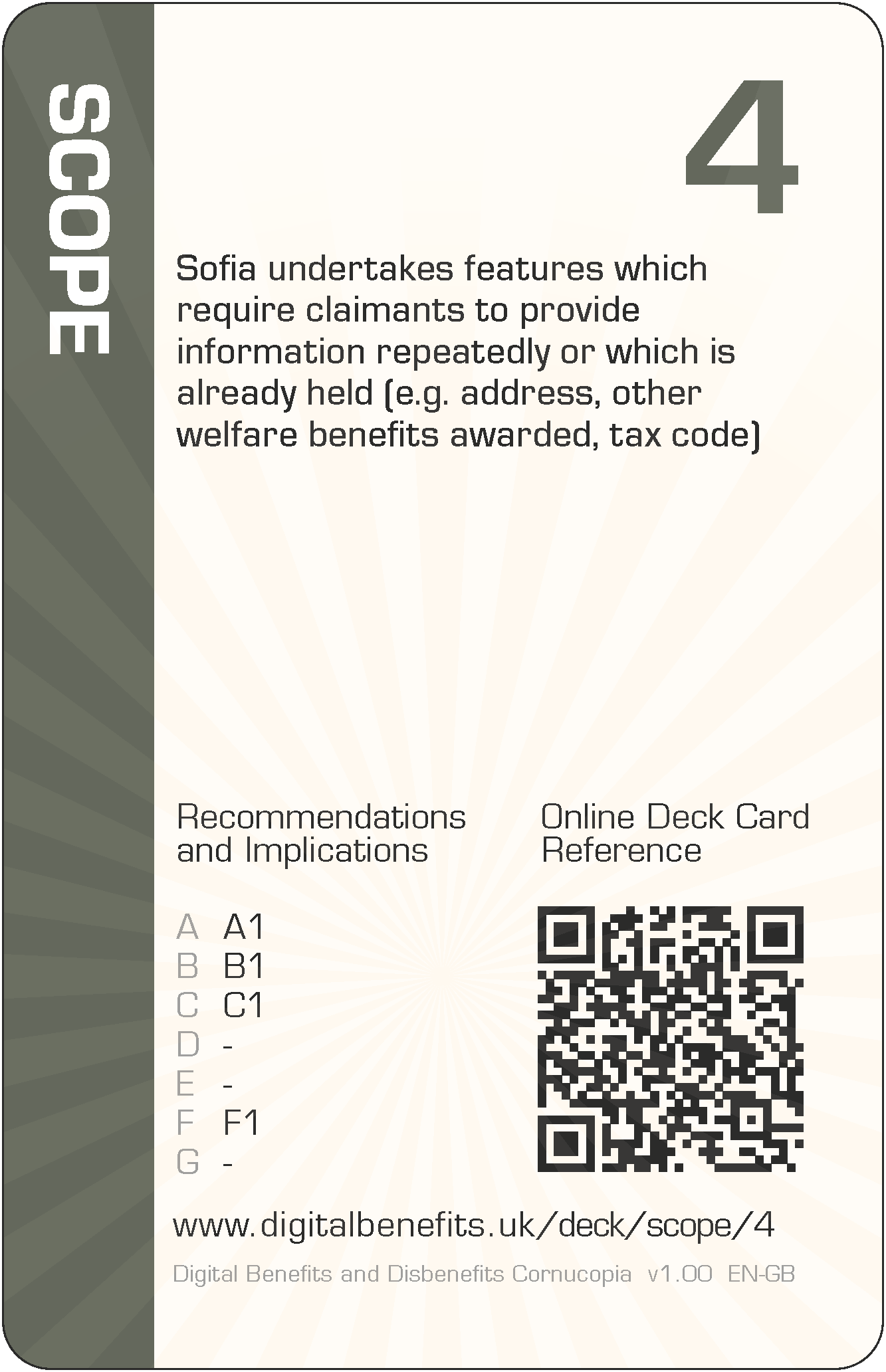Scope 4 (SC-4) Card
DBD Cornucopia > Deck > Scope > 4
Card Details - Four of Scope
Abbreviation
SC-4
Card's focus
The focus of this card is duplication of effort
Threat to claimants
Sofia undertakes features which require claimants to provide information repeatedly or which is already held (e.g. address, other welfare benefits awarded, tax code)

Threat to claimants
Sofia undertakes features which require claimants to provide information repeatedly or which is already held (e.g. address, other welfare benefits awarded, tax code).
Some examples of how this threat could lead to harms (negative effects on claimants)
The design recommendations and implications relevant to the card are listed below in the next section, but even those can be somewhat abstract and difficult to think about during practical day-to-day implementation. Therefore, some example harms are provided to complement the more formal research outputs. These examples are unique per card, and are only published on these web pages (i.e. in no other project outputs).
- The implemented service does recognise which claimants are already claiming another benefit which would alter their award amount, and instead assumes claimants will know to raise this matter, which means awards are often delayed for recalculation, claimants are accused of fraud and some are penalised or sanctioned
- Claimants are given additional work to re-key data (which is already held by the government agency) by entering it into the system, and to do so accurately, because the information re-keyed in is then compared and checked, and used against the claimants if there are differences
- Relevant information on claimants is already held by the government agency, but is not offered to claimants to help them claim, requiring that claimants to understand this and then learn how to and what to provide as evidence
- Claimants have to request underpayments are paid, rather than the payments being made automatically once identified by the system, meaning claimants may miss out on what the money are owed, impacting their finances and then getting into debt
The examples are to help understand the threat on the card, not to suppress thinking and innovation. Incorporating these examples exactly, or closely matching ones, should be scored down when playing DBD Cornucopia as a game.
Applicable design recommendations and implications
These are reproduced here from Research Briefing N
Support claimants’ own ecosystems
- Recognise how wider ecosystems contribute to social protection service delivery
For these systems, the 'service user' is rarely just one person and there should be provision for other actors in people's wider ecosystems. Facilitate and aid these existing assets by enabling, encouraging and promoting information sharing, additional user roles with different privileges, delegated access, real-time-integrations, and other ways to involve the assistance of others.
Acknowledge claimants as people in digital design
- Prioritise claimants' interests over system efficiencies
All digital welfare design processes, methods and decision-making should prioritise claimants' needs to achieve best outcomes for individuals rather than system efficiencies. Organisational knowledge and resources should be utilised to this respect including intervening in advance to identify matters that affect claims or what claimants may have forgotten about.
Reduce claimants’ interaction burdens with digital welfare
- Shift the burden of gathering evidence from claimants towards the state
Transfer effort from claimants to the state, to improve timeliness and reliability. Prioritise the implementation of dig- ital processes to gather or import, check and use necessary data from internal and external providers. Change claimants' role to verifying the data, rather than providing it, and ensure claimants have visibility and control over derived status attributes.
Design to assist claimants across the full span of their own activities
- Provide capabilities for activities prior to, during and after direct public service interaction
Consider the temporal aspects of claimants' activities across the whole lifecycle from before making a claim to after ending an award. Acknowledge how earlier and repeated interventions can reduce later harms, empower claimants and increase the capabilities of claimants.
General Notes
Card values (i.e. '4' for this card) are for game play and are not correlated with the severity of harm. This is because threats cannot be ranked directly since they can affect individuals in different ways due to situations and circumstances, or affect fewer or more claimants, or the harms can arise in claimants' support networks and wider society.
The threat description uses a person's name as the "attacker" (i.e. 'Sofia' for this card), which can be thought of someone involved with implementation. They could have any role which influence digitisation. So they could be a database administrator, or a copy writer, or a quality assurance specialist, etc, or all of these. Everyone could have some influence on the claimant threat described. The names were randomly selected from those currently most popular as given names for boys and girls (UK Office for National Statistics).
The example harms provided are drawn from the research data (which explored not only parts of existing services but also the effects of possible changes to those), from the author's own knowledge of web application development and testing, the author's own experience of helping citizens to claim Universal Credit (UC) and Personal Independence Payment (PIP), and from suggestions submitted by other people (make a suggestion). The threats and example harms do not necessarily exist in the current UC or PIP deployments or in ecosystems around those services, but they might well do.
All the cards in this Scope suit are: 2 3 4 5 6 7 8 9 10 J Q K A
The other suits in the deck are: Architecture, Agency, Trust, Porosity and Cornucopia (plus Jokers).
